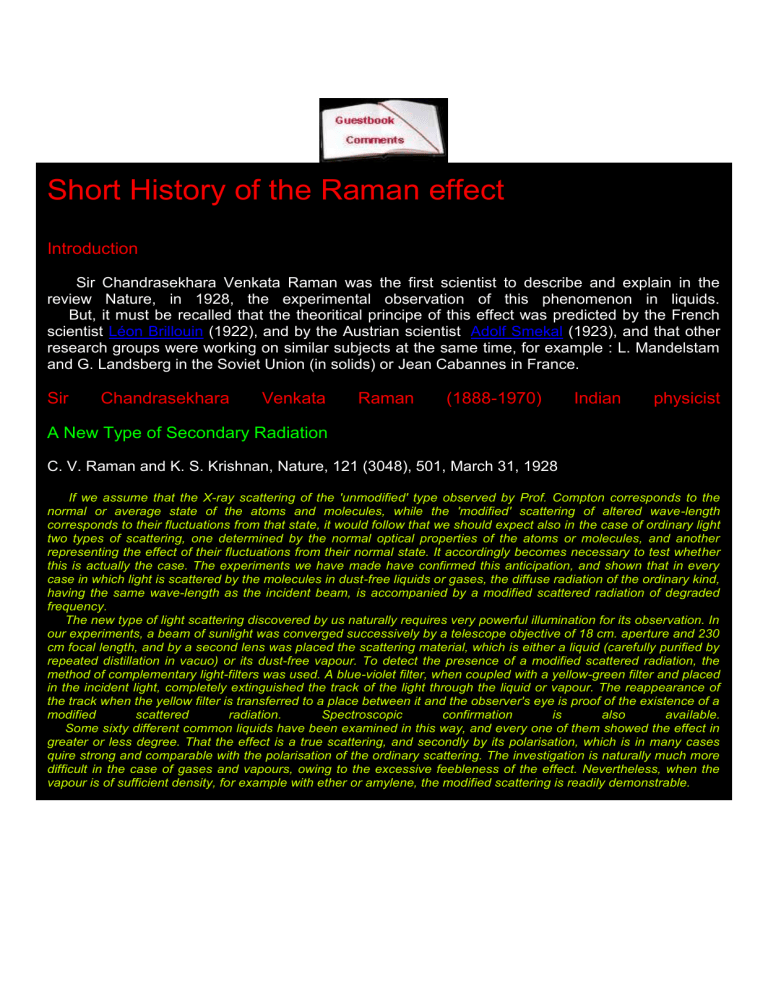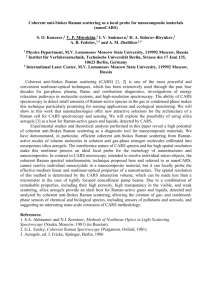Hostory of Ramman Effect

Short History of the Raman effect
Introduction
Sir Chandrasekhara Venkata Raman was the first scientist to describe and explain in the review Nature, in 1928, the experimental observation of this phenomenon in liquids.
But, it must be recalled that the theoritical principe of this effect was predicted by the French scientist Léon Brillouin (1922), and by the Austrian scientist Adolf Smekal (1923), and that other research groups were working on similar subjects at the same time, for example : L. Mandelstam and G. Landsberg in the Soviet Union (in solids) or Jean Cabannes in France.
Sir Chandrasekhara Venkata Raman (1888-1970) Indian physicist
A New Type of Secondary Radiation
C. V. Raman and K. S. Krishnan, Nature, 121 (3048), 501, March 31, 1928
If we assume that the X-ray scattering of the 'unmodified' type observed by Prof. Compton corresponds to the normal or average state of the atoms and molecules, while the 'modified' scattering of altered wave-length corresponds to their fluctuations from that state, it would follow that we should expect also in the case of ordinary light two types of scattering, one determined by the normal optical properties of the atoms or molecules, and another representing the effect of their fluctuations from their normal state. It accordingly becomes necessary to test whether this is actually the case. The experiments we have made have confirmed this anticipation, and shown that in every case in which light is scattered by the molecules in dust-free liquids or gases, the diffuse radiation of the ordinary kind, having the same wave-length as the incident beam, is accompanied by a modified scattered radiation of degraded frequency.
The new type of light scattering discovered by us naturally requires very powerful illumination for its observation. In our experiments, a beam of sunlight was converged successively by a telescope objective of 18 cm. aperture and 230 cm focal length, and by a second lens was placed the scattering material, which is either a liquid (carefully purified by repeated distillation in vacuo) or its dust-free vapour. To detect the presence of a modified scattered radiation, the method of complementary light-filters was used. A blue-violet filter, when coupled with a yellow-green filter and placed in the incident light, completely extinguished the track of the light through the liquid or vapour. The reappearance of the track when the yellow filter is transferred to a place between it and the observer's eye is proof of the existence of a modified scattered radiation. Spectroscopic confirmation is also available.
Some sixty different common liquids have been examined in this way, and every one of them showed the effect in greater or less degree. That the effect is a true scattering, and secondly by its polarisation, which is in many cases quire strong and comparable with the polarisation of the ordinary scattering. The investigation is naturally much more difficult in the case of gases and vapours, owing to the excessive feebleness of the effect. Nevertheless, when the vapour is of sufficient density, for example with ether or amylene, the modified scattering is readily demonstrable.
The Nobel Prize for phyics
Biography
Chandrashekhara Venkata Raman was born to a R. Chandrasekhara Iyer in Tiruchirapalli,
Tamil Nadu. His mother tongue was Tamil. At an early age Raman moved to the city of Vizag,
Andhra Pradesh. His father was a lecturer in mathematics and physics, so he grew up in an academic atmosphere. His nephew Subramanyan Chandrasekhar also won the Nobel Prize in
Physics, in 1983.
Raman entered Presidency College, Chennai, in 1902, and in 1904 gained his B.Sc., winning the first place and the gold medal in physics. In 1907 he gained his M.Sc., obtaining the highest distinctions. He joined the Indian Finance Department as an Assistant Accountant General in
Kolkata
In 1934 Raman became the director of the Indian Institute of Science in Bangalore, where two years later he continued as a professor of physics. Other investigations carried out by Raman were experimental and theoretical studies on the diffraction of light by acoustic waves of ultrasonic and hypersonic frequencies (published 1934-1942), and those on the effects produced by X-rays on infrared vibrations in crystals exposed to ordinary light.
He also started a company called Travancore Chemical and Manufacturing Co. Ltd. in 1943 along with Dr. Krishnamurthy. The Company during its 60 year history, established four factories in Southern India. In 1947, he was appointed as the first National Professor by the new government of Independent India.
In 1948 Raman, through studying the spectroscopic behavior of crystals, approached in a new manner fundamental problems of crystal dynamics. He dealt with the structure and properties of diamond, the structure and optical behavior of numerous iridescent substances (labradorite, pearly feldspar, agate, opal, and pearls). Among his other interests were the optics of colloids, electrical and magnetic anisotropy, and the physiology of human vision.
Raman retired from the Indian Institute of Science in 1948 and established the Raman
Research Institute in Bangalore, Karnataka a year later. He served as its director and remained active there until his death in 1970, in Bangalore, at the age of 82.
He was married on 6 May 1907 to Lokasundari Ammal with whom he had one son,
Radhakrishnan.
Sir Chandrashekhara Venkata Raman
Discovery of the Raman effect
In 1917 Raman resigned from his government service and took up the newly created Palit
Professorship in Physics at the University of Calcutta. At the same time, he continued doing research at the Indian Association for the Cultivation of Science, Calcutta, where he became the
Honorary Secretary. Raman used to refer to this period as the golden era of his career. Many talented students gathered around him at the IACS and the University of Calcutta.
On February 28, 1928, through his experiments on the scattering of light, he discovered the
Raman effect. It was instantly clear that this discovery was an important one. It gave further proof of the quantum nature of light. Raman spectroscopy came to be based on this phenomenon, and
Ernest Rutherford referred to it in his presidential address to the Royal Society in 1929. Raman was president of the 16th session of the Indian Science Congress in 1929. He was conferred a
knighthood, and medals and honorary doctorates by various universities. Raman was confident of winning the Nobel Prize in Physics as well, and was disappointed when the Nobel Prize went to
Richardson in 1928 and to de Broglie in 1929. He was so confident of winning the prize in 1930 that he booked tickets in July, even though the awards were to be announced in November, and would scan each day's newspaper for announcement of the prize, tossing it away if it did not carry the news. He did eventually win the 1930 Nobel Prize in Physics "for his work on the scattering of light and for the discovery of the effect named after him. He was the first Asian and first non-White to get any Nobel Prize in the sciences. Before him Rabindranath Tagore (also Indian) had received the Nobel Prize for Literature.
Bibliography
C. V. Raman, A New Radiation, Indian Journal of Physics, 2, 387 (1928)
C. V. Raman et K. S. Krishnan, A New Class of Spectra due to Secondary Radiation. Part
I., Indian Journal of Physics, 3, 399 (1928)
C.V. Raman et K.S. Krishnan, The production of new radiations by light scattering. Part I.,
Proceeding of the Royal Society of London, AI22, 23-35 (1929)
C.V. Raman, The molecular scattering of light. Nobel Lectures: Physics, 1922-1941, 267-
275 (1930)
The Soviet Union claimed paternity of the Raman effect
Leonid Isaakovich Mandelshtam
Leonid Isaakovich Mandelshtam (Belarusian: Леанід Ісаакавіч Мандэльштам, Russian:
Леонид Исаакович Мандельштам, last name more often spelled as Mandelstam ) (May 4 1879 -
November 27 1944) was a soviet physicist of Belarusian-Jewish background. Mandelstam was born in Mahilyow, USSR (now Belarus) and died in Moscow, USSR (now Russia).
Scientific achievements
Mandelstam founded one of the two major schools of theoretical physics in the Soviet Union
(another being due to Lev Landau). The main emphasis of his work was broadly considered theory of oscillations, which included optics and quantum mechanics. He was a co-discoverer of inelastic combinatorial scattering of light used now in Raman spectroscopy. This paradigm-altering discovery (together with G. S. Landsberg) had occurred at the Moscow State University just one week earlier than a parallel discovery of the same phenomena by C. V. Raman and K. S.
Krishnan.
In Russian literature it is called "combinatorial scattering of light" (from combination of frequencies of photons and molecular vibrations) but in English it is named after Raman.
Mandelstam was mentor in science and life to Igor Y. Tamm, one of the Nobel Prize Laureates in
Physics.
Discovery of the combinatorial scattering of light
In 1918, Mandelstam theoretically predicted the fine structure splitting in Rayleigh scattering due to light scattering on thermal acoustic waves. Beginning from 1926, L.I. Mandelstam and G.S. Landsberg initiated experimental studies on vibrational scattering of light in crystals at the Moscow State University. As a result of this research, Landsberg and Mandelstam discovered the effect of the combinatorial scattering of light on 21 February 1928.
They presented this fundamental discovery for the first time at a colloquium on 27 April 1928. They published brief reports about this discovery
(experimental results with theoretical explanation) in
Russian and in German and then published a comprehensive paper in Zeitschrift fur Physik.
In the same year of 1928, two Indian scientists C.V. Raman and K.S. Krishnan were looking for
"Compton component" of scattered light in liquids and vapors. They found the same combinatorial scattering of light. Raman stated that "The line spectrum of the new radiation was first seen on 28
February 1928". Thus, combinatorial scattering of light was discovered by Mandelstam and
Landsberg a week earlier than by Raman and Krishnan. However, the phenomenon became known as Raman effect.
And the Frenchies...
At that time, a lot of French physicists was specialized in optical spectroscopy and some of them study scattering of light by in gaseous phases. Mention Alfred Kastler, Pierre Daure, Jean
Cabannes and Yves Rocard. In 1928, these 3 last physycists discover the Cabannes - Daure effect but miss the Raman effect.
Auguste Rousset (27/10/1905 - 11/10/1997), young Ph.D. student, working on variation of scattered light polarization, obtain uninterpreted "parasit" components and he will understand the scope only after his return from military service when Raman will publish his results.
Yves Rocard (1903 – 1992) graduate of the Ecole Normale Supérieure, physycist
His first year of research on light scattering by fluids.
He entered the Ecole Normale Superieure (ENS) in 1922 and has received assistance from aggregation of physical sciences in 1925. Fellow of studies at the
Faculty of Sciences of the University of Paris in 1927 he received the Doctor of Mathematics (The hydrodynamics and the kinetic theory of gases) then in 1928 the doctorate in physical sciences (molecular theory of light scattering by fluids). Thesis prepared at laboratory teaching of physics directed by Charles
Fabry). It is then charged to the Foundation Peccot course at the College de France then appointed master of research in 1932. He became a lecturer of physics at the Faculty of Science at Clermont-Ferrand in 1939 and on 1 th October 1939, lecturer in experimental fluid mechanics (and physics) at the
Faculty of Sciences at Paris.
Greater independence of mind pushing such a choice only about his research for his doctorate in physical science: the diffusion of light in liquids. He is a classical physicist mechanic little or not at all prepared to quantum mechanics as many of his colleagues.
At 25 he had anticipated the Raman effect. "Had I been smarter better physical shape more concerned with experimentation I could discover the Raman effect" will write it later .
After the Second World War his role will be decisive for the French research and will emphasize instrumentation and experimentation.







